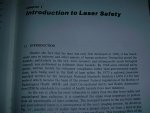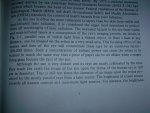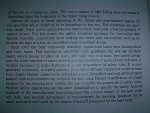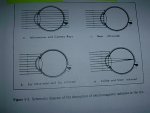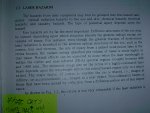hakzaw1
0
- Joined
- Apr 2, 2009
- Messages
- 10,661
- Points
- 113
welcome and TY for reading--
___________________________
LSO--LASER SAFETY OFFICER--
This tutorial will go over the basic outline of the LSO short course.
These are offered at most SELEM events, At FLEM sometimes (because its near to ILDA) and at most big ILDA meetings-
The 'regular' course spans three partial days but even it does not cover in detail everything a LSO needs to know (or to pass the exam) 'normally' IIRC the long
3 day course costs more too- At SELEM ILDA kindly lets us do the one-day short course for lower cost.
TBH I am making this thread not only for those at LPF who want to know more about safety with laser projectors and lasers in general BUT for me as I failed the exam at SELEM 2013 .
(btw to take it at SELEM you will need to spend another night as it happens the day after SELEM ends at the Holiday Inn Express where most stay during SELEM)
update - turns out that another in my class and I (at least) did not have complete training manuals missing 20 some pages which we were allowed to us during the exam- I have been offered a free home 'do-over' for the exam.
AFAIK there are not very many LSOs in the USA- being one can make the difference when it comes to finding a job involving laser projectors/shows.
In the event that a show company gets sued having a trained staff member who is responsible for safe use and training others can make a HUGE difference..
I have about 175 days before SELEM 2014-- If I can afford to go, I can re-take the exam(0nly) for free (I think)- my other choice involves another $100 that I do NOT have ( a take-home email exam with the same two hours to complete & send back)
Another benefit from the LSO and other laser safety courses is knowing how to become a varianced operator which is a must-do for any public display of lasers would technically be 'illegal'.=
.. But IMHO being safe is the most important--so even if you have no intention of ever becoming a LSO, I hope to place here as much info as possible to help you to be safe-- being safe and 'legal' is the best- but at least being safe is good reason to join us in this thread..
What we discuss here will only HELP you to pass the LSO exam AFTER you take the course , (should you ever take the course)--but in no way will it cover every possible exam question--as that does not happen even with the 3 day course. And the learning never stops. goes on forever.
The Exam
you get two short hours and only enough 'spare' time to look up a few answers- we get to use everything we want short of asking for help from others taking the exam-- I saw some very sad faces at LSO SELEM 2011- IIRC only about half passed- my class had MUCH wiser students including one who was retaking both the class and exam and one guy who could write a book on laser safety Steve Roberts- I will urge him to spare us a few minutes from time to time and give this thread some help-
Be sure to thank Steve for helping us out--- he does not get that often enough-
There are more than 200 powerpoint slides-shown at the class.
Some buy a textbook-( I paid 100$ for mine) some get by w/o- its NOT a cheap book -- found mine at Amazon but was told I paid too much for my used edition...
..
has excellent diagrams on the anatomy of the eye=- by far the most in danger is our eyes.
.most of the book covers other types of lasers & we do not need that-- maybe you can find it at a library and copy the best pages-
'Safety with Lasers and Other Optical Sources'
David Sliney and Myron Wolbarsht
Many links can be found on-line- at ILDA, ILD -Pangolin and Pl-Ex-Coherant, UPenn ..etc
for the exam you need the on-line MPE calculators- unless math is your strong point- (not mine)
WE were given a 60+ page Training Manual- we are NOT allowed to copy w/o permission it but I will be using it as a guide to this tut.
This is for US Laser Light Shows and Displays Aug 2010 Version 0.92.
being very dangerous in some cases proper training is a MUST!
The LSO courses (even the 3 day one) do NOT cover everything
and there are questions on the exam that were not covered in class.
Part 1 covers the fundamentals of Laser Operation-- its 30 pages long.
Part 2- Info for LSO and others who are responsible for safety.
Part 3 Technical Considerations
Part 4 Arizona rules ( one of the more strict states)
*************************************
If you only 'THINK'you may want to become a LSO I suggest you follow this thread and start a word file to copy all the links-
to fully understand safety you first need to know how lasers work- the fundamentals. A full understanding of the effects lasers have on our eyes and skin is next --
the different kinds of hazards including non-beam (like a laser falling or trip hazards. ) You need to know the laser classifications and the control measures.
I invite any who see mistakes from me to let me know.
Part 1 will begin on post #3
I will be adding more as time permits-
there is a LOT to cover- and this thread will take months to be anywhere near complete--
hak
I may create a two hour exam when this tut is 'done' and we can see how you did with just two hours--
FYI there will NOT be a LSO course at SELEM 2014 UNLESS enough sign up for it- the planning is well underway and some are already wanting to pay 'buffo' for their spot at SELEM-- which will be one day longer(shows start Thur) due to popular demand..
Aug 14 to 17--2014 set up starts on the Wed. the 13th IIRC
need info?- SEARCH 'SELEM Laser'and see many cool vids at YTube.
:san: hk
update
there were enough to take the class and now they are starting a list for LSO at SELEM 2015 (Aug 12 in Newton NC) on Monday aug 17 8am at HIE.
___________________________
LSO--LASER SAFETY OFFICER--
This tutorial will go over the basic outline of the LSO short course.
These are offered at most SELEM events, At FLEM sometimes (because its near to ILDA) and at most big ILDA meetings-
The 'regular' course spans three partial days but even it does not cover in detail everything a LSO needs to know (or to pass the exam) 'normally' IIRC the long
3 day course costs more too- At SELEM ILDA kindly lets us do the one-day short course for lower cost.
TBH I am making this thread not only for those at LPF who want to know more about safety with laser projectors and lasers in general BUT for me as I failed the exam at SELEM 2013 .
(btw to take it at SELEM you will need to spend another night as it happens the day after SELEM ends at the Holiday Inn Express where most stay during SELEM)
update - turns out that another in my class and I (at least) did not have complete training manuals missing 20 some pages which we were allowed to us during the exam- I have been offered a free home 'do-over' for the exam.
AFAIK there are not very many LSOs in the USA- being one can make the difference when it comes to finding a job involving laser projectors/shows.
In the event that a show company gets sued having a trained staff member who is responsible for safe use and training others can make a HUGE difference..
I have about 175 days before SELEM 2014-- If I can afford to go, I can re-take the exam(0nly) for free (I think)- my other choice involves another $100 that I do NOT have ( a take-home email exam with the same two hours to complete & send back)
Another benefit from the LSO and other laser safety courses is knowing how to become a varianced operator which is a must-do for any public display of lasers would technically be 'illegal'.=
.. But IMHO being safe is the most important--so even if you have no intention of ever becoming a LSO, I hope to place here as much info as possible to help you to be safe-- being safe and 'legal' is the best- but at least being safe is good reason to join us in this thread..
What we discuss here will only HELP you to pass the LSO exam AFTER you take the course , (should you ever take the course)--but in no way will it cover every possible exam question--as that does not happen even with the 3 day course. And the learning never stops. goes on forever.
The Exam
you get two short hours and only enough 'spare' time to look up a few answers- we get to use everything we want short of asking for help from others taking the exam-- I saw some very sad faces at LSO SELEM 2011- IIRC only about half passed- my class had MUCH wiser students including one who was retaking both the class and exam and one guy who could write a book on laser safety Steve Roberts- I will urge him to spare us a few minutes from time to time and give this thread some help-
Be sure to thank Steve for helping us out--- he does not get that often enough-
There are more than 200 powerpoint slides-shown at the class.
Some buy a textbook-( I paid 100$ for mine) some get by w/o- its NOT a cheap book -- found mine at Amazon but was told I paid too much for my used edition...
..
has excellent diagrams on the anatomy of the eye=- by far the most in danger is our eyes.
.most of the book covers other types of lasers & we do not need that-- maybe you can find it at a library and copy the best pages-
'Safety with Lasers and Other Optical Sources'
David Sliney and Myron Wolbarsht
Many links can be found on-line- at ILDA, ILD -Pangolin and Pl-Ex-Coherant, UPenn ..etc
for the exam you need the on-line MPE calculators- unless math is your strong point- (not mine)
WE were given a 60+ page Training Manual- we are NOT allowed to copy w/o permission it but I will be using it as a guide to this tut.
This is for US Laser Light Shows and Displays Aug 2010 Version 0.92.
being very dangerous in some cases proper training is a MUST!
The LSO courses (even the 3 day one) do NOT cover everything
and there are questions on the exam that were not covered in class.
Part 1 covers the fundamentals of Laser Operation-- its 30 pages long.
Part 2- Info for LSO and others who are responsible for safety.
Part 3 Technical Considerations
Part 4 Arizona rules ( one of the more strict states)
*************************************
If you only 'THINK'you may want to become a LSO I suggest you follow this thread and start a word file to copy all the links-
to fully understand safety you first need to know how lasers work- the fundamentals. A full understanding of the effects lasers have on our eyes and skin is next --
the different kinds of hazards including non-beam (like a laser falling or trip hazards. ) You need to know the laser classifications and the control measures.
I invite any who see mistakes from me to let me know.
Part 1 will begin on post #3
I will be adding more as time permits-
there is a LOT to cover- and this thread will take months to be anywhere near complete--
hak
I may create a two hour exam when this tut is 'done' and we can see how you did with just two hours--
FYI there will NOT be a LSO course at SELEM 2014 UNLESS enough sign up for it- the planning is well underway and some are already wanting to pay 'buffo' for their spot at SELEM-- which will be one day longer(shows start Thur) due to popular demand..
Aug 14 to 17--2014 set up starts on the Wed. the 13th IIRC
need info?- SEARCH 'SELEM Laser'and see many cool vids at YTube.
:san: hk
update
there were enough to take the class and now they are starting a list for LSO at SELEM 2015 (Aug 12 in Newton NC) on Monday aug 17 8am at HIE.
Last edited:




